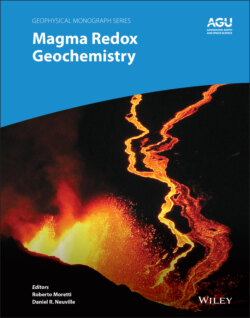Читать книгу Magma Redox Geochemistry - Группа авторов - Страница 27
The Oxidation State of Earth’s Interior, Other Planets, and Meteorites.
ОглавлениеFig. 2.1 summarizes the estimated fO2 of the Solar Nebula, achondrites, and chondrites along with estimates of the fO2 for the interiors of planets including Mars, Mercury, Venus, Earth, and the Moon (Righter et al., 2016). Aubrites and achondrites are the most reduced materials, followed by ordinary chondrites and the oxidized carbonaceous chondrites. These partially overlap with the fO2 determined for Mercury, Martian basalts, and Earth’s mantle rocks; the latter, however, displays a uniquely broad range of values. Although there is geochemical evidence supporting bulk Earth’s origin by accretion from enstatite chondrite material (Javoy, 1995), the fO2 displayed by both appears quite different. Indeed, considerations of the Si isotopic variation and Mg/Si ratio of enstatite chondrites with respect to fertile mantle rocks (Fitoussi & Bourdon, 2012), as well as initial volatile content, are in favor of a multi‐component mixing model involving more than one type of material, with a dominating enstatite chondrite (EH or EL) component, ~30% of carbonaceous chondrites, ~24% achondrites (angrites or eucrites), and a minor amount of ordinary L‐type chondrites (Liebske & Khan, 2019). Importantly, it has been pointed out that Si isotopes are fractionated during core formation (e.g., Georg et al., 2007), nebular processes (Savage & Moynier, 2013), and evaporation during accretion (Pringle et al., 2014). Computational models suggest that the resulting fO2 after accretion must have been low enough (IW‐2) to allow core–mantle separation (Rubie et al., 2015; Schaefer & Fegley, 2017). Early Earth differentiation set a stratified redox interior, with a metallic core below and an FeO‐bearing silicate mantle above the IW buffer. Core‐mantle separation followed by magma ocean crystallization, meteorite impact processes (e.g., Late Heavy Bombardment) involving more oxidized impactors (“heterogeneous accretion”; e.g., O’Neill, 1991) and loss of primordial atmospheres are all likely to have played a major role in the gradula and stepwise oxidation of Earth’s interior (Armstrong et al., 2019), although tight quantitative constraints remain elusive. Recent models suggest that the escape of H2 from the early atmosphere must have been limited being the H2/H2O ratio < 0.3 in the gas released from the magma ocean, and this implies more oxidizing conditions (> IW+1) than those established during equilibrium with the core (Pahlevan et al. 2019).
